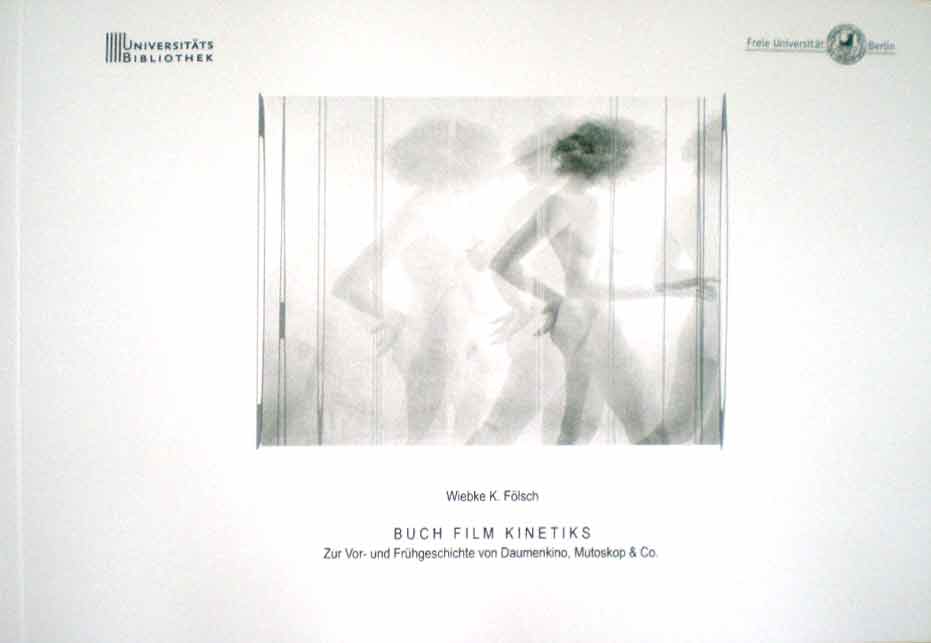|
Forschungsveröffentlichung
|
|
|
|

|
“Schnellsehbuch, Kinophot, Taschenkinematograph, Filoskop, Kinora, Kosmoskop - variantenreich war das Angebot eines höchst produktiven und gewinnbringenden Zweiges der Unterhaltungsindustrie um die Jahrhundertwende zum 20. Jh.
In diesem Buch wird versucht, die Ursprünge und die Produktionsgeschichte dieser Blätterbücher und Blättermaschinen, heute unter dem Namen Daumenkino und Mutoskop bekannt, nachzuzeichnen.”
Herausgeber: Freie Universität Berlin
82 Seiten, ca. 190 Illustrationen und Photos, DIN A5, Auflage 300 Ex., broschur, deutsch, Zusammenfassungen in französisch und englisch, ISBN 978-3-929-619-64-5
|
|
Buch Film Kinetiks
Zur Vor- und Frühgeschichte von
Daumenkino, Mutoskop & Co., 2011
|
|
|
|
|
Buchkritik von Stephen Herbert,
Magic Lantern Society Newsletter Nr. 104, 2011
“Zur Vor- und Fruhgeschichte von Daumenkino, Mutoskop & Co. On the Pre- and Early History of Flick Books, Mutoscopes & Similar Devices’
Wiebke K. Folsch
I bought my first flip book - or flick book, flicker book, etc - from the paydesk at the Barnes Museum of Cinematography, back in 1971. There’s something hypnotically compelling about flipping the pages of these little books and seeing life in realistic photographic motion, or drawings animated into a short movie cartoon. Historical information has always been scattered. There’s some excellent information on one or two specialist websites, and even some DVDs of the older flip books in action. But as far as I know, up until now, it’s been possible to count the number of printed publications specifically about flip books and mutoscopic devices on the thumbs of one hand - which is appropriate, as the flip book needs only a thumb to make it work. The only book that I had seen (not counting The Flip Book Story, a tiny booklet I prepared in the 90s) was the excellent catalogue for DAUMENKINO (The Flip Book Show) from 2005. Now, there is a new publication by flip book artist Wiebke K. Folsch. (Freie Universitat Berlin, 2011). ISBN 978-3-929-619-64-5
This is also published as an exhibition tie-in. Physically small (A5 landscape) 82pp b&w, it packs a lot in: A fascinating chapter on the precursors of the flip book - ancient engravings and even cave paintings with sequential figures that cry out to be animated; The birth of the ‘modern’ (post Linnett’s invention of 1868) flip book; Precursors of Mutoscopes; Animated Page Turning machines; and ‘Vision [Perception] of Animation’. Each chapter is in German, with shorter translations in French and English. With more than 100 small illustrations (mostly patent drawings), a couple of very short flip sequences, and useful spreadsheets of patents. Excellent bibliography and media list. This is a history book - there is no account of recent artists’ works using the flip book even though Wiebke Folsch is very active in the medium today; some of his flip books can be seen in motion on the web. This new book is a good compact introduction to the subject, but also useful for specialists. My copy will be squeezed into my special cabinet, joining some 400 or so flip books that I’ve accumulated over the past 40 years.”
|
|
|
|
|
|
|
|